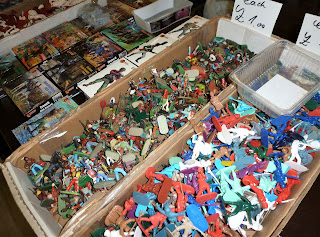I've been going a bit overboard with the medievals this past year or so, to the detriment of collecting other historical periods, but I haven't neglected them entirely:
When I have a little money, I buy Toy Soldiers; and if I have any left, I buy food and clothes. (with apologies to:) ERASMUS
Saturday, 20 September 2025
Other plunder from the Plastic Warrior Show 2025
Wednesday, 14 May 2025
Assorted Ancients now on display.
Following on from the previous post, here are closeups of the second new shelf. The shelves are inside a pine wardrobe built into a chimney alcove, long since unfit for purpose but I'm averse to ripping out period features so it now houses toy soldiers and the original doors provide some protection from the dust.
Wednesday, 23 October 2024
Elastolin Bundeswehr from the car boot sale.
Among the finds at the car boot sale last weekend were these post war composition figures of the German Bundeswehr made by Elastolin, which warrant a post of their own.
Friday, 8 September 2023
Elastolin style trenches
Following on from the previous post, here is a command post I made many years back in the style of the old Elastolin modular trench sections:
Tuesday, 16 May 2023
Plastic Warrior Show 2023
The PW Show has been running annually since 1985 (2 years COVID lockdown excepted), and on Saturday someone said to me "It pretty much runs itself now doesn't it". Well, no it doesn't, there are always problems, there are so many things outside of our control, and the Gods love to have fun with mortals who make plans. This year they had a lot of fun and we had a lot of challenges but the support and camaraderie of the enthusiasts who overcame the travel problems and turned up carried the day. So if you were one of them, thank you, you're the ones who really make the show.
Friday, 21 January 2022
August von Mackensen by Elastolin and Lineol
I've always liked figures of Hussars and Lancers, light cavalry in general I suppose, and here are three examples of composition personality figures portraying Field Marshal von Makensen from the 1930's.
Friday, 14 January 2022
Battle of Metauro revisited
In the closing weeks of last year Anthony and I decided to take his 54mm Battle of Metauro game for another spin, originally this was a board game made in Spain by Rojas y Malaret, Anthony took the original board and had it blown up as a gaming mat for 54mm toy soldiers, here's how the game works: (click on the images to enlarge them)
Tuesday, 17 August 2021
Batalla del Metauro
From the same stable as the Battle of the Little Big Horn game that Anthony and I played back in June comes this Punic Wars game based on the Battle of Metaurus. Originally designed and published in Spain by Rojas y Malaret, as part of a series of games called "Great Battles of the World" then subsequently produced under licence in Germany by O.M.Hausser.


















.JPG)
.JPG)







































